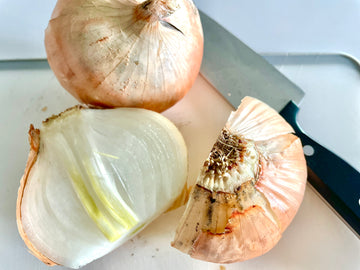Saving, Growing, Making: Onions
Everyone has that lower bin in the refrigerator or corner of the pantry that continuously gets forgotten. Most often it's starchy items like potatoes or those hearty root vegetables that we have good intentions to use but get pushed aside for the easy steamers like broccoli and asparagus.
Onions are the big culprit for us, especially since we tend to buy in bulk, but we believe that it’s important not to waste any food, and to save and use what you can. Even onions growing tops are still useful. Just like an ogre, peel the layers down to what is still good. How many vegetables are that versatile?
Onions can be useful in other ways too. An old English rhyme says that the thickness of an onion can determine how harsh or mild the winter ahead will be. The National Onion Association mentions that onions can be used in dying fabrics, curing bee stings, creating alternative fuel, cleaning grills and feeding sheep.
However you dice them, slice them, freeze them, or roast them in chunks, onions have a wonderful history in American cooking so don't discard those aging onions. With a peel of the skin and flash of a knife, you’ve got a delicious, high fiber water-filled vegetable with lots of vitamin C and antioxidants and benefits that hearken back to our early days.
Onions were abundant in the wild. According to The Dictionary of American Food and Drink, there are about 70 species of onion native to North America including garlic, leek, scallion and shallot, and it is recorded that Father Jacques Marquette, explorer of the southern shore of Lake Michigan in 1624 was able to survive for a time eating a wild onion the Indians called “chicago” or better known as the “tree onion.”
Onions were abundant in cooking. Most people had a root cellar filled with them. Onions save well, dry well and store well with a bit of air circulation. Fannie Farmer in her cookbook first published in the 1890s said onions “should be peeled except when you deliberately leave the skin on to deepen the color of a stock.” And she added a great tip for small onions – drop first into boiling water for a minute, then the skins will slip off easily.
Onions were cultivated in gardens. Thomas Jefferson had a passion for vegetables, and was forever experimenting with seeds, gardening, cooking and creating hybrids, feeling it was his patriotic duty to cultivate and preserve vegetables and fruit. If you’ve ever visited his home in Monticello, Virginia you can see his highly detailed handwritten logs of his efforts – chronicling his failures as much as his successes. He also used his 1,000-foot-long kitchen garden terrace as an experimental laboratory where he cultivated 89 different species and 330 varieties of vegetables.
The onion has a special place in our heart, even if they do make us occasionally shed tears due to their sulphuric compounds. We use them in soups, sauces, stews, roasts, frittatas, casseroles, sautés, scrambles and salads…and love to eat them dipped in oil…and throwing caution to the wind, we admit that fried onion rings are our favorite American staple. While they are widely served today and have become a fast food magnet, the Pig Stand restaurant chain in Oak Cliff, Texas staked their claim as first to serve these in the early 1920s.
History books tell you that during World War II many people were encouraged to grow ‘victory gardens’ in order to help take pressure off the public food supply, but gardens and growing your own food outside a large farm or ranch have long been the mark of an independent American food lifestyle, even into the 1940s and 1950s.
Our great grandparents in small town Texas could never imagine having to buy tomatoes, herbs, onions, lettuces, string beans, beets, watermelon, zucchini, peas and squash not to mention the plentiful apple, pear, peach, walnut and pecan trees in the neighborhood that made the very best pies on earth. A grocery store often carried dry goods and the fresh were supplied other places. It may seem a novel idea if you shop primarily at a grocery store, but many of these food products were grown and given away for free.
As one of the third most consumed fresh vegetables on earth, we’re proud onions have a particular sweet spot in American food history. They are incorporated into every cultural food we serve. They were even carried in the berth of the Mayflower to be a garden crop. In true American style, instead of continuing to import them from England, onions soon became a crop sold to other nations as the American farmer flourished.
Whether you buy onions or cultivate them yourself, it’s worth remembering the value of the fresh foods we have and to use them for good health, good meals and gathered times of family memories. And just remember, even though the Pilgrims never knew the enjoyment of stuffing, you can’t have a traditional Thanksgiving meal without them.


